#extinction of insects
Explore tagged Tumblr posts
Text
The love for nature leaving my body after spotting one (1) mosquito

6K notes
·
View notes
Text
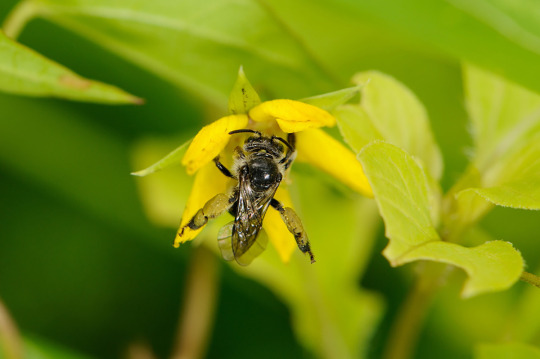
Xerces Society: Announcing The State Of The Bees Initiative: Our Plan To Study Every Wild Bee Species In The U.S.
This is really exciting news! For those unaware, the Xerces Society has been focusing on invertebrate conservation for over fifty years, and has pioneered a lot of the work to bring awareness to the devastating losses of not only insects but other terrestrial and aquatic invertebrates. It gets its name from the Xerces blue butterfly (Glaucopsyche xerces), the first North American butterfly driven to extinction by human activities.
Even if you haven't heard of the Xerces Society, you've probably come across various "Save the Bees!" campaigns. These frequently focus on the domesticated European honey bee (Apis mellifera), which, while it may be important to crop pollination in many parts of the world, is not a part of natural ecosystems in places like the Americas and Australia, and can be considered an invasive species at times. With the rise of colony collapse disorder (CCD) particularly after the turn of the 21st century, where entire domestic honeybee colonies would die off, the need to preserve bees began to gain wider public acknowledgement.
But what many people don't realize is that it is the thousands upon thousands of other native bee species worldwide that are in greater danger of extinction. They don't have armies of beekeepers giving them safe places to live and treating them for diseases and parasites. More importantly, where honey bees may visit a wide variety of plants, native bees often have a much narrower series of species they visit, and they are quite vulnerable to habitat loss. Most bees are not as social as honey bees and live solitary lives, unseen by the casual observer.
Invertebrates in general often suffer from a lack of conservation information, meaning that particularly vulnerable species may fly under the radar and risk going extinct without anyone realizing until it's too late. This ambitious program by the Xerces Society aims to solve that problem, at least for the 3,600+ species of bee in the United States. If they can assign a conservation status to each one, then that strengthens the argument toward protecting their wild habitats and working to increase their numbers. Hopefully it will also prompt more attention to other under-studied species that are in danger of going extinct simply because we don't know enough about them.
#bees#save the bees#invertebrates#arthropods#insects#entomology#nature#wildlife#animals#ecology#environment#conservation#science#scicomm#endangered species#extinction#pollinators#Xerces Society#Xerces blue
596 notes
·
View notes
Text

Scientists' warning to humanity on insect extinctions
by University of Huddersfield
Some of the tiniest creatures on the planet are vital for the environment. But there is a worldwide fall in insect numbers after an accelerating rate of extinction. Now, a global group of 30 scientists—including University of Huddersfield lecturer Dr. Matt Hill—has highlighted the issue and suggests practical steps that everyone can take to help halt the decline. These include mowing lawns less often, avoiding pesticides and leaving old trees, stumps and dead leaves alone...
Read more: https://phys.org/news/2020-04-scientists-humanity-insect-extinctions.html
494 notes
·
View notes
Text

writing eulogies for species we haven't yet lost mourning a world full of tiny lives i could never save
128 notes
·
View notes
Text
Endangered Fireflies & Conservation
Fireflies are at risk of extinction due to habitat destruction, light pollution, and pesticide use. Recovery efforts started in 2023 for the 18 endangered species in North America. Almost 1 in 3 firefly species in the US and Canada are threatened with extinction.
Scientists have yet to prove the effectiveness of these steps due to limited research on firefly populations. However, there is evidence suggesting that human activities may contribute to the decline of fireflies. So, here's what you can do:
Turn off outside lights during nighttime hours
Allow logs and leaves to naturally decompose in your yard
Incorporate areas of water into your landscaping
Refrain from using pesticides in your yard
Avoid excessive mowing of your lawn
Plant native tree species in your yard.
Please take a moment to explore resources related to firefly conservation:
Discover articles from the Xerces Society on firefly conservation: https://www.xerces.org/endangered-species/fireflies
Watch a video from the Canadian Permaculture Legacy on saving fireflies: https://www.youtube.com/watch?v=McjHyQMf5eQ
Learn more about the Firefly Conservation & Research organization: http://www.firefly.org/
Explore their articles on how you can contribute to firefly conservation: https://www.firefly.org/how-you-can-help.html
If you have spotted fireflies in your area, please report your sightings here: https://www.firefly.org/firefly-sightings.html
#fireflies#firefly#lightning bug#bugs#insects#conservation#endangered species#north america#Xerces Society#Fire fly#extinction#environment#cottagecore#gardening#permaculture#agriculture#light pollution#Canada#United States#habitat destruction#habitat loss#restoration#glow worm
211 notes
·
View notes
Text
never go into the notes of a post that asks people to consider why they hate specific animals so much. anyways if you think a specific animal should go extinct I will explode you 😁👍👍👍👍👍
#pig originals#IM SO TIRED OF THE 'oh i totally agree with this BUT'#ENOUGH!!! ENOUGH!!! DONT YOU HAVE ENOUGH HATRED IN YOUR HEART...#'kill them' 'we don't Need them in the environment' 'they are unnecessary' You Annoy Me And I Do Not Like You.#stop... i dont get it what makes people think we have the right to kill so many animals#why are people so gleefully discussing the nonexistence of certain bugs. you can be afraid of them whatever idgaf but LORD#stop suggesting specific insects need to die i will actually GET you!!!!!! STOP!!!!!!!!!!!!!!!!!!!!!!!!!!#you dont even gaf about the environment you dont do your research on trophic levels and you dont do your research on#how important every animal is. and how much of a loss each extinction is.#AND REGARDLESS OF THAT WHY SHOULD YOU GAF THOSE ARE LIVING BEINGS WHY DO THEY DESERVE LIFE LESS FOR BEING BORN THAT WAY#IM GOING TO KILL SOMEONE!!!!!!!!!!!!!!!!!!!!!!!!!#youre just using your discomfort with animals to justify all of them dying? what the fuck man.
121 notes
·
View notes
Text

alt mode
510 notes
·
View notes
Text
Oht fucking god there's insects EVERYWHERE
#mumbles#there's DEAD insects in my computer#they seem to really like my computer#can they all go extinct already
27 notes
·
View notes
Text
CBD from Hemp Kills Mosquitoes, Inflicting 100% Mortality Rate on Pesticide-Resistant Insects https://www.goodnewsnetwork.org/cbd-from-hemp-kills-mosquitoes-inflicting-100-mortality-rate-on-pesticide-resistant-insects/
#obviously we dont want mosquito extinction but pest control is good#good news#environmentalism#science#environment#nature#animals#insects#mosquitoes#cbd#hemp#plants#medicinal herbs
45 notes
·
View notes
Text

X is for Xerces Blue Butterfly
Xerces blue butterflies can only be seen in museums. They went extinct when buildings replaced San Francisco's coastal sand dunes.
31 notes
·
View notes
Text
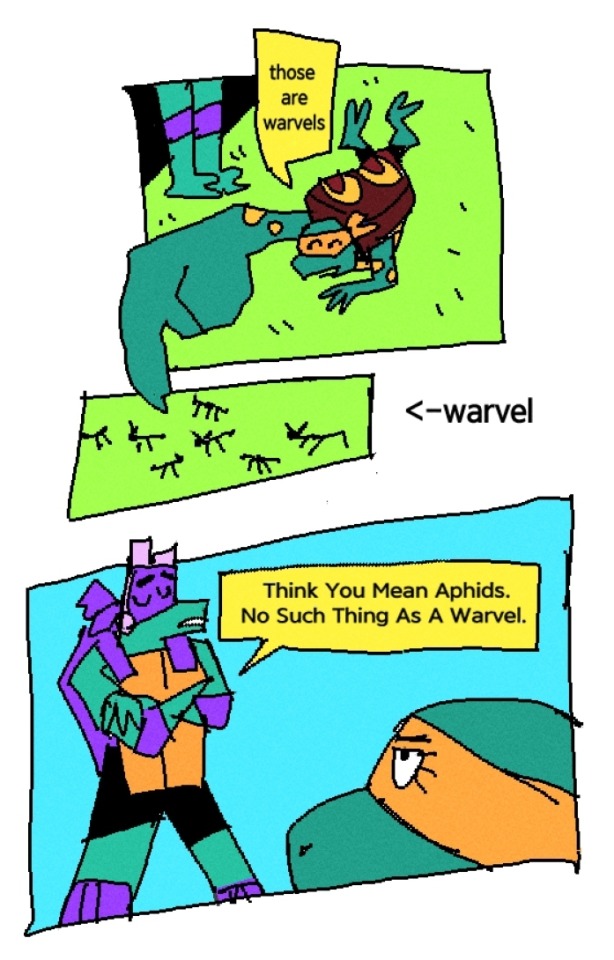
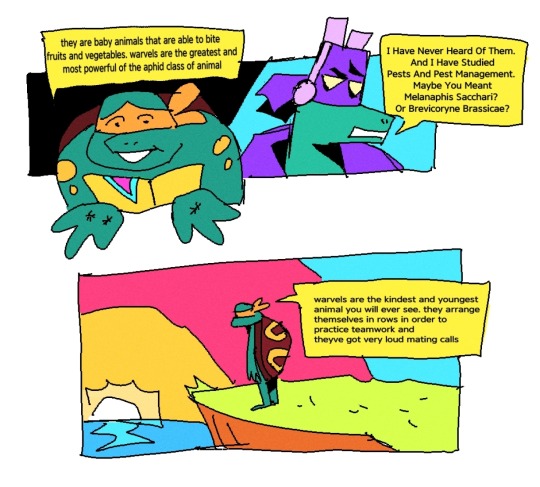
the warvel comic (og)
#scheduled post. this is actually mmmm pretty old#authors note: no warvels are not real or a real animal at that and i am pretty sure this is also a made up word#sorry#i believe that mikey could be great at coming up with very beautiful and awesome fantastical creatures#and he talks about those made up animals like they are very very real and he sounds and is very very convincing#and donnies like no mikey thats not true i know all animals and none of your animals are real see (and he lists down every single animal)#extinct or extant#but mikey is unbothered#because he loves speculative zoology#immovable AUTISM encounters unstoppable AUTISM#my art#tmnt#rottmnt#donnie#mikey#rottmnt donnie#rottmnt mikey#bright colors#insects
96 notes
·
View notes
Text
This is very exciting news indeed! The dark bordered beauty moth (Epione vespertaria) is found across Europe, but in Britain its habitat has been so reduced that it is now only found in three small areas in Scotland. Intensive captive breeding efforts starting last year led to a release of 160 caterpillars earlier this year, and researchers were delighted to find two adult male moths from that clutch a few weeks ago.
While it's certainly possible to import members of the same species from other parts of Europe, it's crucially important to save the local population. Individual populations of a given species may have unique genes, and add diversity and strength to the overall species' gene pool.
Like the Oregon silverspot butterfly similarly reintroduced in my area of the Pacific Northwest, the caterpillars of the dark bordered beauty have a limited diet, in this case aspen trees. They're not the most common tree in the region, and due to overpopulation of deer as well as livestock grazing they often have a tough time getting a foothold as the herbivores mow them down before they can grow large enough to survive a little browsing. I don't know whether the unnamed site where the caterpillars were released is also seeing more aspens planted, but deliberate habitat restoration will need to see these trees protected and perhaps propagated as well.
In the meantime, I wish these little moths (and their caretakers) the very best in reclaiming their historic range!
#good news#habitat restoration#endangered species#extinction#moths#lepidoptera#caterpillars#insects#invertebrates#animals#wildlife#nature#restoration ecology#ecology#conservation#environment#biodiversity
645 notes
·
View notes
Text
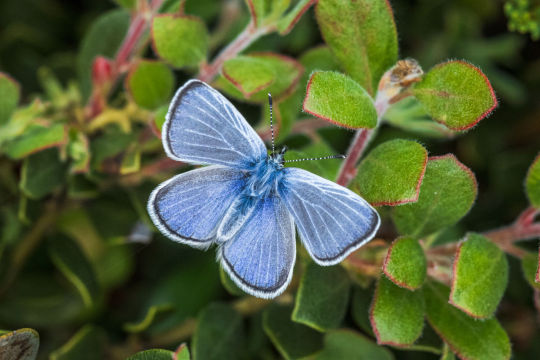
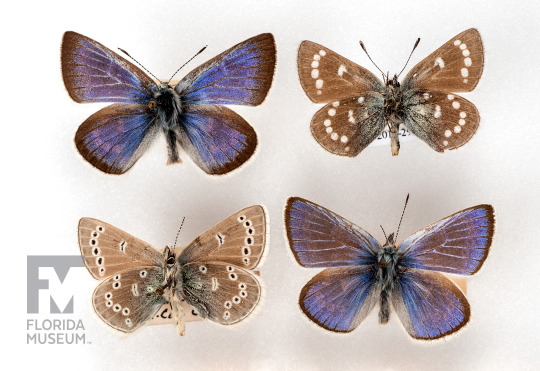
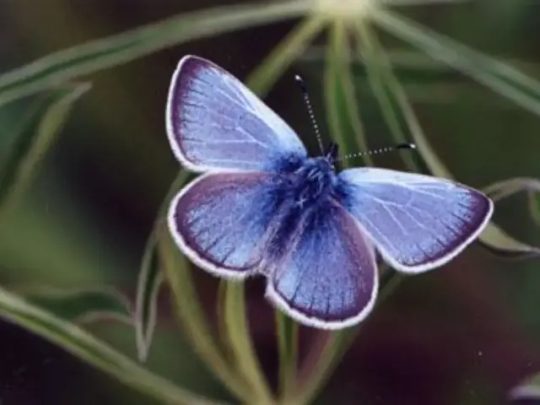
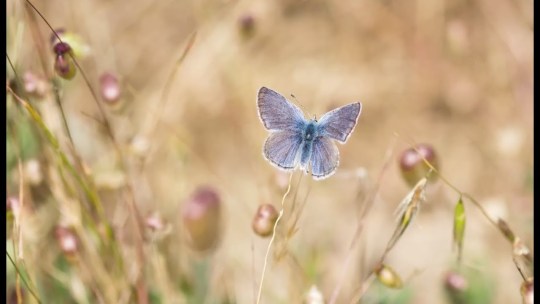
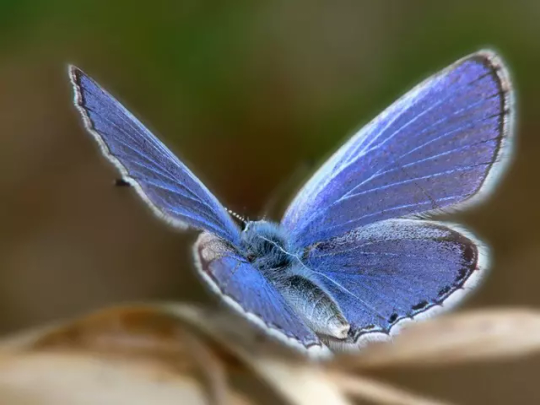
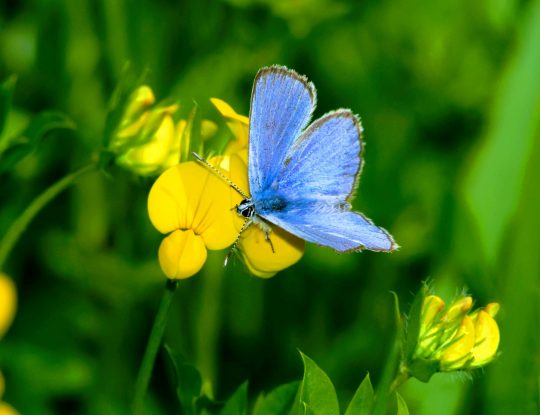

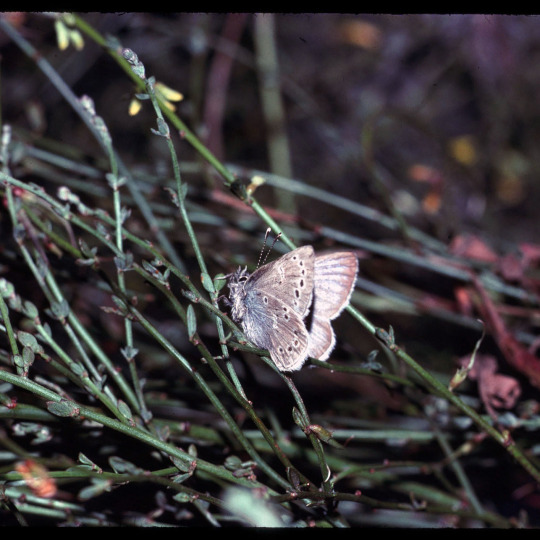
Glaucopsyche xerces, better known as the Xerces blue butterfly or simply xerces blue is a recently extinct species of butterfly in the gossamer-winged butterfly family, Lycaenidae. The species was first described and documented in 1852, and was named after the French spelling of "Xerxes", the Greek name of the Persian kings Xerxes I and Xerxes II of the fifth century BC. Reaching around .7 to 1.18inches (18 to 30mm) in wingspan length, the xerces blue is a small, brightly colored butterfly characterized by iridescent blue on the upper wing surfaces of males, and pale spots below. It was endemic to the coastal sand dunes of the upper San Francisco Peninsula where the Xerces fed on vegetation belonging to the genus Lotus and Lupinus. The loss of the Lotus plant that the butterfly fed on while in its larval stages is believed to be the main reason for the extinction of the Xerces blue. As growing urban development resulted in extensive disturbance and loss of habitat of which the lotus plant couldn’t survive. Lupinus, the Xerces blue's other main adult food source, was not suitable for the larval stages. By the early 1940s the Xerces Blue was driven to extinction, becoming one of the first and most well-known butterflies in the United States lost due to human impact, with the last confirmed sighting of a xerces blue occurring in 1943 on land that is now part of the Golden Gate National Recreation Area. The butterfly’s extinction inspired the foundation of the Xerces Society for Invertebrate Conservation in 1971, as well as ushering the need for insect and invertebrate conservation into the public mindset. Today there are ongoing efforts to reestablish related butterflies in the Xerces blue's former habitat such as the silvery blue and the Palos Verdes blue. Also the possibility of reviving the xerces blue via de-extinction is being explored.
#pleistocene pride#pliestocene pride#cenozoic#holocene#extinct#animal#animals#insect#butterfly#animal facts#xerces#xerces blue#bug#bugs
28 notes
·
View notes
Text
Time Travel Question 38: Pre-History Continued
These Questions are the result of suggestions from the previous iteration.
This category may include suggestions made too late to fall into the correct earlier time grouping. Basically, I'd already moved on to human history, but I'd periodically get a pre-homin suggestion, hence the occasional random item waaay out of it's time period, rather than reopen the category.
In some cases a culture lasted a really long time and I grouped them by whether it was likely the later or earlier grouping made the most sense with the information I had. (Invention ofs tend to fall in an earlier grouping if it's still open. Ones that imply height of or just before something tend to get grouped later, but not always. Sometimes I'll split two different things from the same culture into different polls because they involve separate research goals or the like).
Please add new suggestions below if you have them for future consideration. All cultures and time periods welcome.
#Time Travel#Friesenhahn Cave#Homotheriums#Mammoth#Megafauna#Pre-History#Ceratopsia#Dinosaurs#Carboniferous#Insects#Evolution#Jellyfish#Sea Creatures#Spinosaur#Hallucigenia#Lepidodendrons#Extinct Plants
60 notes
·
View notes
Text
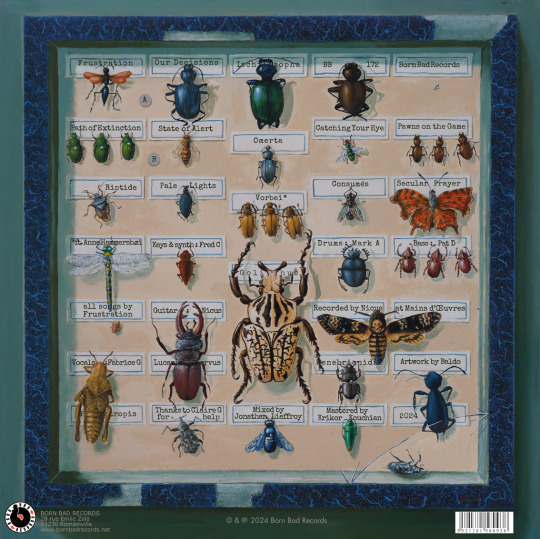
Voici le verso du nouvel album « Our Decisions » du groupe Frustration, label Born Bad Records.
Baldo 2023, Acrylique sur carton 50X50 cm
#Acrylique sur carton
#baldomeroortas
#acryliquesurcarton
#acrylpainting
#baldo
#baldo ortas
#baldoortas
#art
#insects
#extinction
#environment
#extinctionrebellion
#entomology
#frustration#Our Decisions
#ourdecisions
#boites entomologiques
#baldo#baldomero ortas#baldo ortas#acrylique sur carton#frustration#baldomeroortas#baldoart#boites entomologiques#ourdecisions#entomology#insects#hemiptera#arthropods#lepidoptera#extinctionrebellion#extinction#acrylic
34 notes
·
View notes